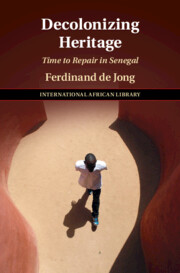Book contents
- Decolonizing Heritage
- The International African Library
- Decolonizing Heritage
- Copyright page
- Dedication
- Contents
- Figures
- Acknowledgements
- Prologue
- Introduction
- 1 History and Testimony at the House of Slaves
- 2 The Door of Return
- 3 Shining Lights and Their Shadows
- 4 Prayer of Emergency
- 5 Recycling Recognition
- 6 Ruins of Utopia
- 7 The Museum of Black Civilizations
- Coda
- Bibliography
- Index
- The International African Library
6 - Ruins of Utopia
Ponty and the University of the African Future
Published online by Cambridge University Press: 10 March 2022
- Decolonizing Heritage
- The International African Library
- Decolonizing Heritage
- Copyright page
- Dedication
- Contents
- Figures
- Acknowledgements
- Prologue
- Introduction
- 1 History and Testimony at the House of Slaves
- 2 The Door of Return
- 3 Shining Lights and Their Shadows
- 4 Prayer of Emergency
- 5 Recycling Recognition
- 6 Ruins of Utopia
- 7 The Museum of Black Civilizations
- Coda
- Bibliography
- Index
- The International African Library
Summary
General Faidherbe founded the École normale William Ponty in Saint-Louis to train the sons of colonial chiefs and assimilate them in French culture. In the early twentieth century, the school was moved from Saint-Louis to Gorée, then to Sébikotane, just beyond Rufisque. During the colonial era, the school educated many African students hailing from all over Afrique-Occidentale Française, several of whom went on to lead their countries into independence and became their first presidents. President Abdoulaye Wade was one of the Ponty students. This chapter examines Wade’s initiative to establish the University of the African Future on the same site where the ruins of the Ponty School stand today. It looks at the architecture of the campus, the envisioned curriculum, and its stated aim to stop the brain drain from Africa. Conceived as a Pan-African institution, the university was placed alongside the Ponty School as its postcolonial incarnation. However, as the funding for the project fell through due to changing international politics, the site now houses the ruins of two educational infrastructures standing side by side. This chapter examines how both infrastructures were conceived as Afro-utopias and generated Afro-nostalgia for futures to come.
Keywords
- Type
- Chapter
- Information
- Decolonizing HeritageTime to Repair in Senegal, pp. 185 - 210Publisher: Cambridge University PressPrint publication year: 2022

